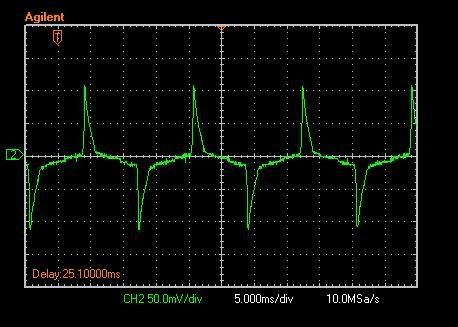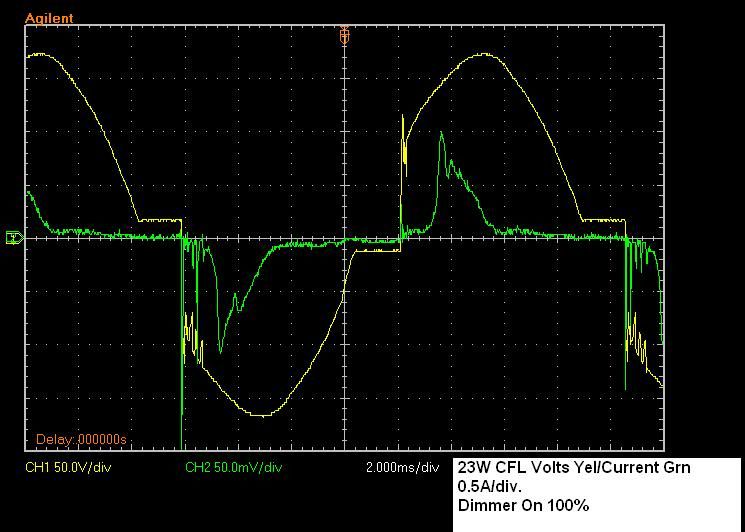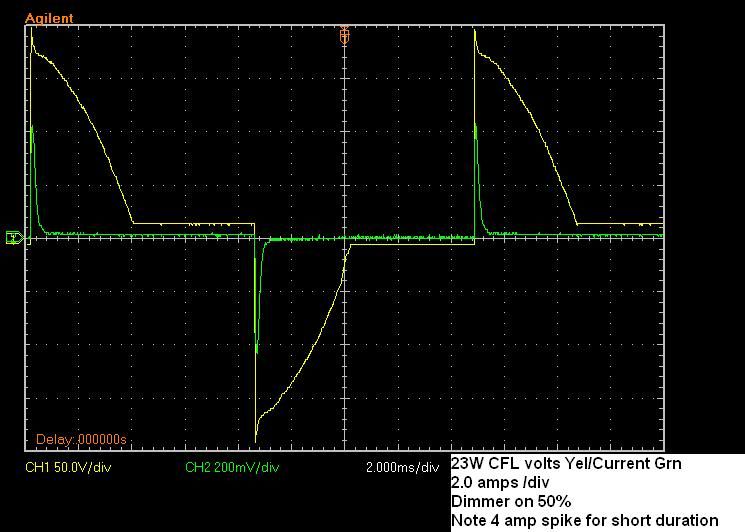We have 5 switches that get very hot when turned on (heat gun readings up to 145 degrees). This is fairly new installation (conference room), with dimmer switches and CFLs. The 2nd bank of switches don't seem to get as hot. The contractor that did the installation said that the switches are with in allowable tolerance......I'm having troubling swallowing that information, can anyone explain what is allowable/ acceptable???
You are using an out of date browser. It may not display this or other websites correctly.
You should upgrade or use an alternative browser.
You should upgrade or use an alternative browser.
Hot light switches
- Thread starter rhatch
- Start date
- Status
- Not open for further replies.
- Location
- Chapel Hill, NC
- Occupation
- Retired Electrical Contractor
I tend to believe the contractor. Dimmer switches must dissipate the heat and they can get very hot. Some of the fin dimmers may help but they must be installed in individual boxes.
I am assuming the wattage of the lights is equal to or less than the dimmer rating.
I am assuming the wattage of the lights is equal to or less than the dimmer rating.
145? is a bit higher than what I have normally seen, but anytime you group dimmers the cumulative effect certainly seems to take effect.
Not to second-guess your electrician, but a common mistake when grouping dimmers is not to take into account that on higher wattage units, to group them you have to break off some of the heat sinks (fins) and there wattage allowance is reduced.
I often find this mistake on groups where the E/C has failed to take into account the wattage rating once the fins have been broken.
As Dennis notes, 1st make sure the installed wattage doesn't exceed the dimmer rating, then also make sure it doesn't exceed the "revised" rating if the fins were removed.
Not to second-guess your electrician, but a common mistake when grouping dimmers is not to take into account that on higher wattage units, to group them you have to break off some of the heat sinks (fins) and there wattage allowance is reduced.
I often find this mistake on groups where the E/C has failed to take into account the wattage rating once the fins have been broken.
As Dennis notes, 1st make sure the installed wattage doesn't exceed the dimmer rating, then also make sure it doesn't exceed the "revised" rating if the fins were removed.
We have 5 switches that get very hot when turned on (heat gun readings up to 145 degrees). This is fairly new installation (conference room), with dimmer switches and CFLs. The 2nd bank of switches don't seem to get as hot. The contractor that did the installation said that the switches are with in allowable tolerance......I'm having troubling swallowing that information, can anyone explain what is allowable/ acceptable???
I spy with my little eye a big red flag.
- Location
- Chapel Hill, NC
- Occupation
- Retired Electrical Contractor
Good point but they may be electronic ballast CFL-- you know the 4 pin type perhaps.I spy with my little eye a big red flag.
hot switches
hot switches
After another look at the lights, there are 30 Sylvania 26W CFL type lights per switch. One of the switches on the other bank (of switches), gets warm..(but not hot). I will have to get the specs of the switches to verify wattage.
Based on the limited info I have here, should we have the 1000w switches? Thanks
hot switches
After another look at the lights, there are 30 Sylvania 26W CFL type lights per switch. One of the switches on the other bank (of switches), gets warm..(but not hot). I will have to get the specs of the switches to verify wattage.
Based on the limited info I have here, should we have the 1000w switches? Thanks
Yes you should have the 1000 watt switches, as the calculated load is 30 x 26 = 780 watts, and remember that ballast losses will make the actual number higher.
I think that even 1,000w dimmers wouldn't be adequate, when you add in ballast loss and the need for derating the grouped dimmers.
Whoever designed this load messed up big time.
Your best and safest bet is to replace the switches with a Lutron dimming system and control panel, they make high current dimming modules suitable for CFL's.
I think that even 1,000w dimmers wouldn't be adequate, when you add in ballast loss and the need for derating the grouped dimmers.
Whoever designed this load messed up big time.
Your best and safest bet is to replace the switches with a Lutron dimming system and control panel, they make high current dimming modules suitable for CFL's.
LarryFine
Master Electrician Electric Contractor Richmond VA
- Location
- Henrico County, VA
- Occupation
- Electrical Contractor
Gotta make sure the CFL's are dimmable, and that the dimmers are CFL-compatible.... with dimmer switches and CFLs.
..................Whoever designed this load messed up big time................
It may not have been designed that way. It may have just ended up that way.
Original plan was for incandecent lamps on regular switches. Then dimmers got added. Then the owners stuck CLFs in to save money on the utility bill (not knowing).
Guess what?........... Problem!
Stopmoving
Member
- Location
- Orlando, Fl.
I have a question on this subject, in regards to volt-amps vs. watts. What is the power factor for cfl's? Would this impact the total "load" that the switch is seeing?
It may not have been designed that way. It may have just ended up that way.
Original plan was for incandecent lamps on regular switches. Then dimmers got added. Then the owners stuck CLFs in to save money on the utility bill (not knowing).
Guess what?........... Problem!
Then it's an even bigger screw-up on the design because think about it: MINIMUM wattage for incandescents would be 40 watts EACH, times the 30 lamps and now you have 1,200 watts MINIMUM.
So someone was asleep at the switch, literally.
I have a question on this subject, in regards to volt-amps vs. watts. What is the power factor for cfl's? Would this impact the total "load" that the switch is seeing?
That is a very broad question with no clear cut answer. The PF of a cfl will depend on its design, and will vary from brand to brand.
I have heard they are around .8pf but don't know if that's lead or lag.
Last edited:
gar
Senior Member
- Location
- Ann Arbor, Michigan
- Occupation
- EE
100320-1611 EST
On dimming CFLs. My tests on a sample of one GE and one Phillips dimmable CFL showed very poor dimming capability with phase shift dimming. And these are designed to work with phase shift dimming. Minimum dim level for the GE was about 35% and for the Phillips 39%. Less than a 3 to 1 range.
A different subject. Using sine wave excitation the GE has little variation with voltage, but quits about 100 V. It is a good bulb to use where someone has lights that dim momentarily when large motors turn on, such as air conditioners. The Phillips is similar to the GE and drops out about 93 V.
On the other hand if I adjust sine wave voltage to at least some standard CFLs I get somewhat better dimming than with phase shift dimming to special CFLs. This is more curiosity than useful because Variacs are large and expensive.
Most phase shift dimmers probably use a Triac as the device to control current. The Triac like the SCR stays conducting once triggered until the current thru the device drops below the holding current level. You can read this as turning off at or near a current zero-crossing. When on, the voltage drop across the Triac or SCR is moderately constant relative to current. Typically maybe 1.5 V. @ 10 A, and this is a very approximate 15 W. Obviously current waveform has an effect. 15 W in a small space is a lot of power to dissipate.
The poor dimming capability of CFLs implies that the dimmers should be used with incandescents. With a good phase shift dimmer I can get a 20 to 1 intensity change.
I suggest that the customer go back to incandescent bulbs to get effective dimming. You need more individually adjusted dimmers for the load you have, or multiple dimmers that can be controlled from a single knob. This will reduce the localized heat.
.
On dimming CFLs. My tests on a sample of one GE and one Phillips dimmable CFL showed very poor dimming capability with phase shift dimming. And these are designed to work with phase shift dimming. Minimum dim level for the GE was about 35% and for the Phillips 39%. Less than a 3 to 1 range.
A different subject. Using sine wave excitation the GE has little variation with voltage, but quits about 100 V. It is a good bulb to use where someone has lights that dim momentarily when large motors turn on, such as air conditioners. The Phillips is similar to the GE and drops out about 93 V.
On the other hand if I adjust sine wave voltage to at least some standard CFLs I get somewhat better dimming than with phase shift dimming to special CFLs. This is more curiosity than useful because Variacs are large and expensive.
Most phase shift dimmers probably use a Triac as the device to control current. The Triac like the SCR stays conducting once triggered until the current thru the device drops below the holding current level. You can read this as turning off at or near a current zero-crossing. When on, the voltage drop across the Triac or SCR is moderately constant relative to current. Typically maybe 1.5 V. @ 10 A, and this is a very approximate 15 W. Obviously current waveform has an effect. 15 W in a small space is a lot of power to dissipate.
The poor dimming capability of CFLs implies that the dimmers should be used with incandescents. With a good phase shift dimmer I can get a 20 to 1 intensity change.
I suggest that the customer go back to incandescent bulbs to get effective dimming. You need more individually adjusted dimmers for the load you have, or multiple dimmers that can be controlled from a single knob. This will reduce the localized heat.
.
ELA
Senior Member
- Occupation
- Electrical Test Engineer
Another thing to consider is the peak power that the dimmers will be required to dissipate with CFLs. CFLs have a very nonlinear current demand as shown here:

Scale is 0.5 amps /div.
This is a 15Watt CFL. Note that it draws 1 amp peak.
With 30 of these you could be looking at a 30 amps peak or 3600 watts peak.

Scale is 0.5 amps /div.
This is a 15Watt CFL. Note that it draws 1 amp peak.
With 30 of these you could be looking at a 30 amps peak or 3600 watts peak.
ELA
Senior Member
- Occupation
- Electrical Test Engineer
CFLs are hard on Dimmers!
CFLs are hard on Dimmers!
My previous post showed a 15 Watt CFL powered full on to show how the CFL draws a lot of current for a short time.
Now a follow up:
As has been mentioned the dimming range of CFLs is pretty poor and this is due in part to the fact hat the current "spike" is not drawn until after the peak voltage reaches ~125V.
For this reason very poor dimming is accomplished from 100% down to the 50% setting. Then from 50% downward the dimming works much better.
Here are two diagrams of a 23 Watt (75 watt equiv) CFL who's claim to fame is their dimmability (Greenlite).
The first is with the dimmer full on (dimmer is a unit with a neutral).
You can see the 1 amp current spike drawn after approx. the 60 degree point in the voltage waveform.

The second shows the dimmer at near the 50% setting. Note the 4 amps current spike when the unit first turns on each half cycle.

When set at the 50% point you can easily audibly hear the dimmer humming.
Imagine a dimmer feeding 30 of these CFLs.
CFLs are hard on Dimmers!
My previous post showed a 15 Watt CFL powered full on to show how the CFL draws a lot of current for a short time.
Now a follow up:
As has been mentioned the dimming range of CFLs is pretty poor and this is due in part to the fact hat the current "spike" is not drawn until after the peak voltage reaches ~125V.
For this reason very poor dimming is accomplished from 100% down to the 50% setting. Then from 50% downward the dimming works much better.
Here are two diagrams of a 23 Watt (75 watt equiv) CFL who's claim to fame is their dimmability (Greenlite).
The first is with the dimmer full on (dimmer is a unit with a neutral).
You can see the 1 amp current spike drawn after approx. the 60 degree point in the voltage waveform.

The second shows the dimmer at near the 50% setting. Note the 4 amps current spike when the unit first turns on each half cycle.

When set at the 50% point you can easily audibly hear the dimmer humming.
Imagine a dimmer feeding 30 of these CFLs.
- Status
- Not open for further replies.
